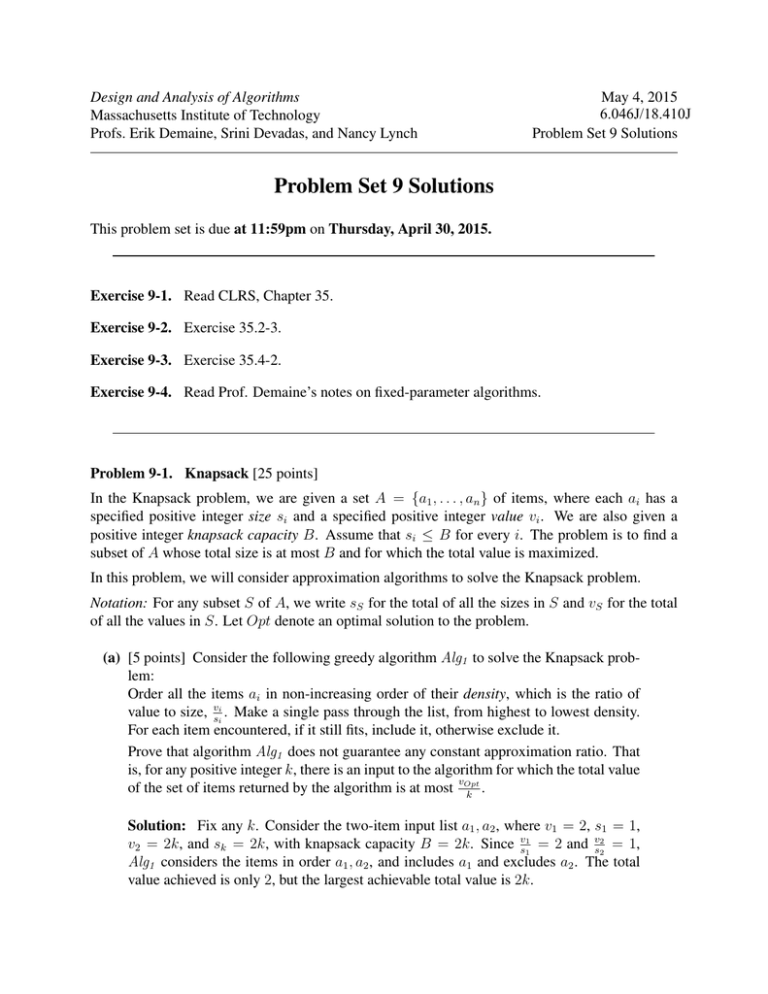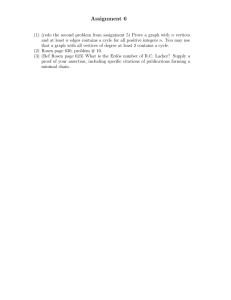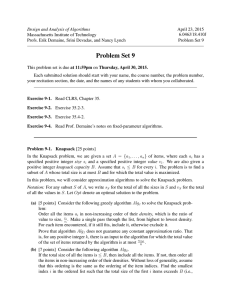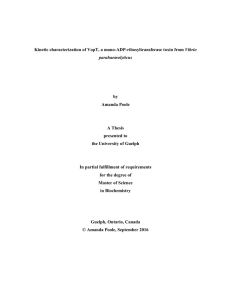6.046J/18.410J
advertisement

Design and Analysis of Algorithms
Massachusetts Institute of Technology
Profs. Erik Demaine, Srini Devadas, and Nancy Lynch
May 4, 2015
6.046J/18.410J
Problem Set 9 Solutions
Problem Set 9 Solutions
This problem set is due at 11:59pm on Thursday, April 30, 2015.
Exercise 9-1. Read CLRS, Chapter 35.
Exercise 9-2. Exercise 35.2-3.
Exercise 9-3. Exercise 35.4-2.
Exercise 9-4. Read Prof. Demaine’s notes on fixed-parameter algorithms.
Problem 9-1. Knapsack [25 points]
In the Knapsack problem, we are given a set A = {a1 , . . . , an } of items, where each ai has a
specified positive integer size si and a specified positive integer value vi . We are also given a
positive integer knapsack capacity B. Assume that si ≤ B for every i. The problem is to find a
subset of A whose total size is at most B and for which the total value is maximized.
In this problem, we will consider approximation algorithms to solve the Knapsack problem.
Notation: For any subset S of A, we write sS for the total of all the sizes in S and vS for the total
of all the values in S. Let Opt denote an optimal solution to the problem.
(a) [5 points] Consider the following greedy algorithm Alg1 to solve the Knapsack prob­
lem:
Order all the items ai in non-increasing order of their density, which is the ratio of
value to size, vsii . Make a single pass through the list, from highest to lowest density.
For each item encountered, if it still fits, include it, otherwise exclude it.
Prove that algorithm Alg1 does not guarantee any constant approximation ratio. That
is, for any positive integer k, there is an input to the algorithm for which the total value
v
of the set of items returned by the algorithm is at most Opt
.
k
Solution: Fix any k. Consider the two-item input list a1 , a2 , where v1 = 2, s1 = 1,
v2 = 2k, and sk = 2k, with knapsack capacity B = 2k. Since vs11 = 2 and vs22 = 1,
Alg1 considers the items in order a1 , a2 , and includes a1 and excludes a2 . The total
value achieved is only 2, but the largest achievable total value is 2k.
2
Problem Set 9 Solutions
(b) [7 points] Consider the following algorithm Alg2 .
If the total size of all the items is ≤ B, then include all the items. If not, then order all
the items in non-increasing order of their densities. Without loss of generality, assume
that this ordering is the same as the ordering of the item indices. Find the smallest
index i in the ordered list such that the total size of the first i items exceeds B (i.e.,
i
i−1
i−1
j=1 sj > B, but
j=1 sj ≤ B). If vi >
j=1 vj , then return {ai }. Otherwise,
return {a1 , . . . , ai−1 }.
Prove that Alg2 always yields a 2-approximation to the optimal solution.
Solution: We know that fractional knapsack problem can be solved via greedy algo­
rithm; the optimal solution for fractional knapsack problem takes first i − 1 items, and
takes some fraction α of item i. That is, fractional knapsack optimal solution vf Opt is
vf Opt =
i−1
i
vj + αvi .
j=1
Since every knapsack problem is a valid fractional knapsack problem, we know that
vOpt ≤ vf Opt .
Now consider the solution output by Alg2 .
i−1
i−1
i
i
vf Opt
max(
vj , vi ) ≥ max(
vj , αvi ) ≥
,
2
j=1
j=1
because at least one of the two terms needs to be larger than half of vf Opt . Therefore,
we have
i−1
i
vOpt ≤ vf Opt ≤ 2 max(
vj , vi ),
j=1
which shows that Alg2 is a 2-approximation algorithm.
Solution: This is an alternate solution.
Assume for contradiction that there is some input instance for which Alg2 does not
achieve a 2-approximation to the optimal solution. Then for i as specified in the
vOpt
algorithm, the maximum of vi and i−1
j=1 vj is strictly less than 2 . That is, both
vOpt
i
vi and i−1
j=1 vj are strictly less than 2
. Then
j=1 vj < vOpt . We also know that
i
j=1 sj > B.
Let C = {a1 , . . . , ai } − Opt, D = Opt − {a1 , . . . , ai }, and E = {a1 , . . . , ai } ∩ Opt.
i
We know that vC = ij=1 vj − vE , and vD = vOpt − vE . Since j=1
vj < vOpt , we
i
now have that vC < vD . We also know that sC > sD , since j=1 sj > B and sD ≤ B.
Therefore, the density of C is strictly less than the density of D (i.e., vsCC < vsDD ).
Problem Set 9 Solutions
3
j
Now recall that the densities of {a1 , . . . , an } are non-increasing. Consider
j:vj ∈C
j
j:vj ∈C
vj
sj
−
j
j:vj ∈C (vj si −vi sj )
v
. We know that sjj ≥ vsii for aj ∈ C, and thus vj si − vi sj > 0.
s
s
i
j
j:vj ∈C
v
This implies that vsCC ≥ vsii, and similar argument holds for vsDD ≤ sj
j . Therefore,
vC
D
≥ vsii ≥ vsD
. This contradicts our result from the previous paragraph that says
s
vC
v
C
D
< sD , and Alg2 must be a 2-approximation.
sC
vi
sj
=
j
(c) [5 points] Let A = {a1 , . . . , an } be the input ordered arbitrarily, and V be the largest
value for any item; then nV is an upper bound on the total value that could be achieved
by any solution. For every i ∈ {1, . . . , n} and v ∈ {1, . . . , nV }, define Si,v to be the
smallest total size of a subset of {a1 , . . . , ai } whose total value is exactly v; Si,v = ∞
if no such subset exists.
Give a dynamic programming algorithm Alg3 to solve Knapsack exactly. Specifically,
give a recurrence to compute all values of Si,v , and explain how to use this to solve
the Knapsack problem. Analyze its time complexity.
Solution:
S1,v = s1 if v1 = v, and = ∞ otherwise.
For 1 ≤ i ≤ n − 1:
Si+1,v = min{Si,v , si+1 + Si,v−vi+1 } if vi+1 ≤ v, Si,v otherwise.
The computation of all of these values takes time O(n2 V ). As usual for dynamic
programming algorithms, we can add bookkeeping to calculate the actual subsets as
we go along. The maximum total value achievable is max vlSn,v ≤ B. The final
output is a subset of A whose total value is this maximum.
Since the time complexity O(n2 V ) depends linearly on V , which is represented in
binary in the input to the problem, Alg3 is a pseudo-polynomial-time algorithm.
(d) [8 points] Finally, we develop Alg4 , which is a Fully Polynomial Time Approximation
Scheme (FPTAS) for Knapsack. The idea is to use an exact dynamic programming
algorithm like the one in Part (c), but instead of using the given (possibly large) values
for the items, we use versions of the given values that are suitably scaled and rounded
down. As in Part (c), order A = {a1 , . . . , an } arbitrarily, and let V be the largest value
for any item.
For any ε, 0 < ε < 1, Alg4 behaves as follows:
For each item ai with value vi , define a scaled value vi� = l( vVi )( nε )J.
Using these scaled values (and the given sizes), run Alg3 and output the set C of items
that it returns.
Prove that Alg4 is a FPTAS for Knapsack.
Solution:
4
Problem Set 9 Solutions
By Part (c), the running time of the algorithm is O(n2 b( VV )( nε )c) = O(n2 b nε c), which
is polynomial in n and 1ε .
It remains to show that the set C returned by the algorithm has total value vC ≥
(1 − ε)vOpt .
vi
Let K denote εV
, so each vi0 = b K
c. It follows that vi0 K ≥ vi − K. Considering all
n
0
the elements of O, we get vO
pt K ≥ vOpt − nK.
Now consider the set C that is returned by the dynamic programming step. We have
that vC ≥ KvC0 . Also, since the set C is optimal in terms of the scaled values, we have
0
vC0 ≥ vO
pt . Therefore, we have:
0
vC ≥ KvC0 ≥ KvO
pt ≥ vOpt − nK = vOpt − εV ≥ vOpt − εvOpt = (1 − ε)vOpt . This
is as needed.
Problem 9-2. Fixed-Parameter Algorithms [25 points]
We consider the Tournament Edge Reversal problem. Define a tournament to be a directed graph
T = (V, E) such that, for every pair of vertices u, v ∈ V , exactly one of (u, v) and (v, u) is in E.
Furthermore, define a cycle cover to be a set A ⊂ E of directed edges of a tournament T such that,
every directed cycle of T contains at least one edge from A.
(a) [5 points] Let a minimal cycle cover of T be a cycle cover with the least number of
edges. Prove that reversing all the edges of a minimal cycle cover A turns T into an
acyclic tournament. (Hint: Any edge e ∈ A must be the only edge in A on some
directed cycle of T .)
Solution: Let T 0 be the new tournament. Suppose for contradiction that T 0 contains
a cycle C. Let F 0 be the set of edges of C that were obtained by reversing the edges
of A, and let F be their reversals, which are edges in T . For each e ∈ F , let Ce be a
directed cycle of T that e covers. From the hint, we know e is the only edge in A that
is also in Ce .
Now we can construct a cycle C 0 in T , consisting entirely of edges of T that did not
get reversed: Include all reverse of edges in C − F 0 (which are valid edges in T ), and
for each e ∈ C ∩ F 0 , include all the edges of Ce except for e. This yields a cycle C 0 in
T that contains no edges in A, which is a contradiction.
In the Tournament Edge Reversal problem, we are given a tournament T and a positive integer k,
and the objective is to decide whether T has a cycle cover of size at most k.
(b) [15 points] Show that this problem has a kernel with at most k 2 + 2k vertices. (Hint:
Define a triangle to be a directed cycle of length 3. Consider the number of times that
a node or an edge appears in different triangles.)
Solution:
Problem Set 9 Solutions
Part (a) implies that a tournament T has a cycle cover of size at most k if and only if
it can be turned into an acyclic tournament by reversing directions of at most k edges.
We will use this characterization for the kernel. We give two simple reduction rules:
Rule 1: If an edge e is contained in ≥ k + 1 triangles, then reverse e and reduce k by
1.
This rule is safe because if we do not reverse e, we must reverse at least one edge from
each of k + 1 triangles containing e. Thus e belongs to every cycle cover of size ≤ k.
Rule 2: If a vertex v is not contained in any triangle, then delete v from T .
To see why this is safe, let X be the set of vertices u such that T contains the edge
(v, u) (the outgoing neighbors of v), and let Y be the set of vertices u such that T
contains the edge (u, v) (the incoming neighbors of v). X and Y partition the vertices
in V − {v}. Since v is not contained in any triangle, there is no edge from X to
Y . Thus, every directed cycle in T is either wholly contained within the subgraph
induced by X or the subgraph induced by Y . Therefore, removing v and its incident
edges from T does not affect the size of the minimum cycle cover.
Thus, starting with instance (T ; k) = (T0 ; k0 ), we apply our reduction rules repeatedly
until they cannot be applied any longer, obtaining a sequence of equivalent instances
(T1 ; k1 ), (T2 ; k2 ), . . . , (Tm ; km ) = (T 0 ; k 0 ), where neither Rule is applicable to the final
instance (T 0 ; k 0 ).
Claim: If T 0 has a cycle cover A0 of size ≤ k 0 , then T 0 has at most k 0 (k 0 + 2) vertices.
Proof of claim: Since Rule 2 is not applicable, every vertex of T 0 is in a triangle, which
must contain some edge in A0 . Since Rule 1 is not applicable, for every edge e ∈ A0 ,
there are at most k 0 vertices other than e’s endpoints that are in triangles containing e.
Since |A0 | ≤ k 0 , it follows that T 0 has at most k 0 (k 0 + 2) vertices.
Thus, after reducing, we consider the final instance (T 0 , k 0 ). If T 0 has more than
k 0 (k 0 + 2) vertices, then it cannot have a cycle cover of size ≤ k 0 , and is a no-instance.
By equivalence, (T, k) is also a no-instance. We return no in this case. Otherwise, we
get the desired kernel with at most k 2 + 2k vertices.
(c) [5 points] Obtain a FPT algorithm for the Tournament Edge Reversal problem.
Solution:
Given an instance (T, k) for the Tournament Edge Reversal problem, use the algorithm
from Part (b) to either determine that (T, k) is a no-instance or obtain a kernel (T 0 , k 0 )
where k 0 ≤ k and T 0 has at most k 0 (k 0 + 2) vertices. In the former case, answer
“no”. In the latter case, run any algorithm with running time g(k 0 ), for any function g,
to solve the Tournament Edge Reversal problem on (T 0 , k 0 ). Return the result as the
answer.
To reduce the problem, we have to check for all triangles, and check membership of
all edges
and vertices in the triangles. For vertices, to check all triangles, it takes
|V |
O( 2 ) per vertex. For edges, it takes |V | per edge. Each reduction step thus takes
5
6
Problem Set 9 Solutions
O(|V |3 +|V ||E|)). There are at most V +E reduction steps since each step removes an
edge or a vertex. In total, reduction takes O(|V |4 +|V |3 |E|+|V |2 |E|+|V ||E|2 ). Since
O(|E|) = O(|V |2 ) in tournaments, this is O(|V |5 ). To find the minimum cycle cover,
/2 /
2
one solution is to check all possible subsets of edges in T 0� . There are O(2k (k +2) )
subsets, and for each subset we need to run a cycle finding algorithm, such as DFS, to
4
ensure all cycles are covered. Therefore, the final time complexity is O(|V |5 )+2O(k ) .
MIT OpenCourseWare
http://ocw.mit.edu
6.046J / 18.410J Design and Analysis of Algorithms
Spring 2015
For information about citing these materials or our Terms of Use, visit: http://ocw.mit.edu/terms.






